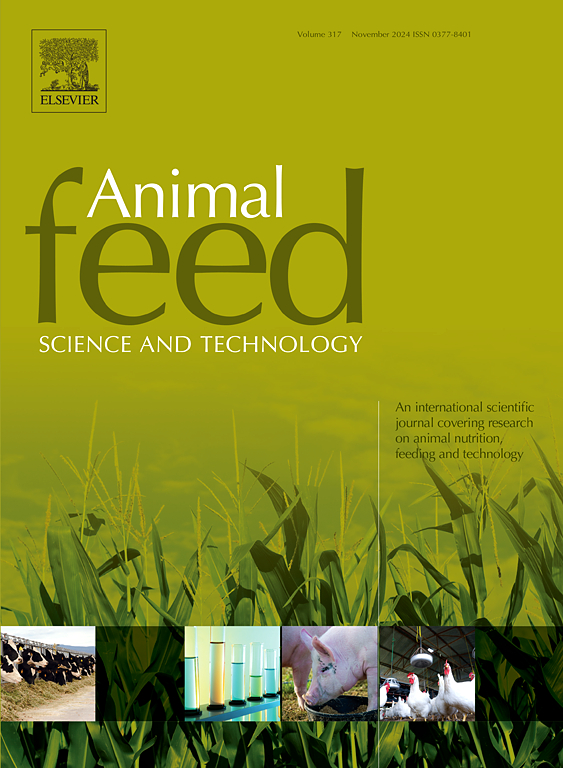Effects of feeding prickly pear by-product silage as a partial replacement of concentrate on dairy ewes: Milk characteristics, nutrient utilisation and in vitro ruminal fermentation
IF 2.5
2区 农林科学
Q1 AGRICULTURE, DAIRY & ANIMAL SCIENCE
引用次数: 0
Abstract
Prickly pear fruit processing industries generate a substantial amount of fibrous by-products as waste rich in bioactive compounds, including polyphenols and tannins, and that contain considerable minerals and water-soluble carbohydrates. This study investigated the potential of prickly pear by-product silage as feed in the diet of Valle del Belice ewes and its effects on body weight, milk yield and composition, nutrient utilisation and degradability and in vitro ruminal fermentation characteristics. A total of 12 ewes (60 d in lactation) were selected and randomly divided into three experimental groups, homogeneous for parity, live weight and milk yield. Each group was fed for 14 d (9 d for diet adaptation + 5 d for sampling), with one of the three experimental diets based on a Latin square design. The diets with the same crude protein and NDF were: 1) control (CTR) diet with hay and concentrate; 2) prickly pear peels (PPP) diet with PPP silage, hay and concentrate; and 3) pulp, peels and seeds (PPS) diet with PPS silage, hay and concentrate. Nutrient intake varied between diets, with total DM intake being greater in the CTR and PPS (p < 0.01) diets than in the PPP diet. Daily milk yield tended to be lower in ewes fed the PPP and PPS diets than in those fed the CTR diet, whereas no differences were found for fat- and protein-corrected milk between diets. Protein and casein (p ≤ 0.05) levels were higher in the milk of ewes fed the PPP diet. Compared with the milk urea concentration of CTR-fed ewes, that of PPP-fed ewes was 15 % lower. The in vivo nutrient degradability, in vitro fermentation rate and volatile FAs were greater (p < 0.01) in the PPP diet than in the PPS diet. These results suggest that PPP silage can be partially incorporated into dairy ewe diets to reduce feeding costs and improve milk nitrogen efficiency.
饲喂刺梨副产物青贮部分替代精料对奶羊的影响:乳特性、营养物质利用和体外瘤胃发酵
仙人掌果加工工业产生大量的纤维副产品,作为富含生物活性化合物的废物,包括多酚和单宁,并且含有大量的矿物质和水溶性碳水化合物。本试验旨在研究刺梨副产物青贮在白肋谷母羊饲粮中作为饲料的潜力及其对体重、产奶量和乳成分、营养物质利用和降解率以及体外瘤胃发酵特性的影响。选取12只泌乳期60 d的母羊,随机分为胎次、活重和产奶量均相同的3个试验组。每组饲喂14 d (9 d为日粮适应期+ 5 d为抽样期),采用拉丁方设计的3种试验日粮中的一种。相同粗蛋白质和NDF的饲粮为:1)干草和精料的对照饲粮;2)刺梨皮(PPP)饲粮,配以PPP青贮、干草和精料;3)以PPS青贮、干草和精料为原料的PPS(果肉、果皮和种子)饲粮。不同饲粮的营养摄入量存在差异,CTR和PPS饲粮的DM总摄入量高于PPP饲粮(p <; 0.01)。饲喂PPP和PPS饲粮的母羊的日产奶量往往低于饲喂CTR饲粮的母羊,而在脂肪和蛋白质校正乳方面,两种饲粮之间没有发现差异。饲喂PPP饲粮的母羊奶中蛋白质和酪蛋白水平较高(p ≤ 0.05)。与cbr饲喂母羊相比,ppp饲喂母羊的乳尿素浓度降低了15 %。PPP饲粮的体内养分降解率、体外发酵率和挥发性FAs均高于PPS饲粮(p <; 0.01)。综上所述,PPP青贮可部分添加到母羊日粮中,以降低饲养成本,提高乳氮利用率。
本文章由计算机程序翻译,如有差异,请以英文原文为准。
求助全文
约1分钟内获得全文
求助全文
来源期刊

Animal Feed Science and Technology
农林科学-奶制品与动物科学
CiteScore
6.00
自引率
6.20%
发文量
266
审稿时长
3 months
期刊介绍:
Animal Feed Science and Technology is a unique journal publishing scientific papers of international interest focusing on animal feeds and their feeding.
Papers describing research on feed for ruminants and non-ruminants, including poultry, horses, companion animals and aquatic animals, are welcome.
The journal covers the following areas:
Nutritive value of feeds (e.g., assessment, improvement)
Methods of conserving and processing feeds that affect their nutritional value
Agronomic and climatic factors influencing the nutritive value of feeds
Utilization of feeds and the improvement of such
Metabolic, production, reproduction and health responses, as well as potential environmental impacts, of diet inputs and feed technologies (e.g., feeds, feed additives, feed components, mycotoxins)
Mathematical models relating directly to animal-feed interactions
Analytical and experimental methods for feed evaluation
Environmental impacts of feed technologies in animal production.
 求助内容:
求助内容: 应助结果提醒方式:
应助结果提醒方式:


